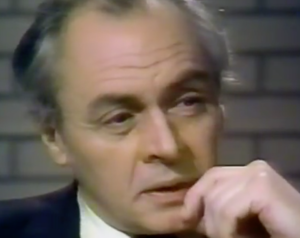Ronald David Laing: A Schizophrenia Reseacher

Ronald David Laing was a British psychiatrist known for his alternative approach to schizophrenia treatment. He was also the founder of a movement that would go on to be known as anti-psychiatry in the 1960s and 70s.
Like many other psychologists and social scientists, Laing worked and conducted research at the famous Tavistock Clinic. Many years later, he ended up becoming part of the research team at the Tavistock Institute. The institute made sure he had more than enough money to conduct his important studies.
He focused primarily on studying schizophrenia and the treatment environment of schizophrenic patients. Laing suggested that they acted differently based on the environment they were in. Keep reading to learn more about Ronald David Laing’s life and his important work.

Ronald David Laing: Early life
Laing was born on October 7th, 1927 in Govanhill, Glasgow (Scotland). He came from a working-class family and was the only child of David McNair Laing and Amelia Laing.
Until 1945, he attended Hutcheson, an all-boys primary school in Glasgow, where he stood out as an excellent student and musician. He got his accreditation from the Royal Academy of Music in 1944 and began to attend the Royal College of Music in April 1945.
During his time at that school, he was an avid student of philosophy. Some of the authors he found most interesting were Freud, Marx, Nietzsche, and, above all, Kierkegaard. Later on, he started to study medicine and psychiatry and got his medical degree from the University of Glasgow in 1951.
A vocation for psychiatry
Between 1951 and 1953, he served as a conscripted psychiatrist for the Royal Army Medical Corps. They sent him to the Psychiatric Unit for the British Army in Netley (near Southampton), and later on to the Military Hospital in Catterick, Yorkshire.
Towards the end of 1953, he left the army and began to teach at the University of Glasgow. During this time, he went to Gartnavel Royal Hospital to complete his training as a psychiatrist. In this hospital, he tried an experimental treatment environment: the “Rumpus Room”, where schizophrenia patients could have fun and relax.
Both staff and patients wore normal clothing and they let the patients spend time doing things such as cooking and doing artistic activities. These day-to-day activities were meant to provide the patients with an environment where they could interact with the staff and other patients in a social environment, rather than an institutional one.
All of his patients improved after this novel treatment. In January of 1956, Laing received his certification as a psychiatrist.
Laing’s professional life
At the end of 1956, Ronald David Laing earned the title of senior registrar at the Tavistock Clinic in London. He researched there until 1960.
Doctors at the Tavistock Clinic primarily studied patients from the English navy. Their main goal was to identify the marks and scars war could leave on people.
The Tavistock Institute came not long after, as a non-governmental, non-profit organization. Founded by the Rockefeller Foundation, the Tavistock Institute carried out research in social sciences and psychology, with a focus on education, research, and professional development.
Ronald David Laing worked at the Institute for nearly 30 years. At the same time, the Institute of Psychoanalysis also took him on to receive certification as a psychoanalyst.
In 1958, he began the research that would give rise to his book, Sanity, Madness, and the Family, published in 1964. He also created a series of seminars that involved a wide range of people, some of whom would go on to become major collaborators. Among them were Aaron Esterson and David Cooper.
Laing’s work and recognition
His bookThe Divided Self was published in 1960. It received positive reviews, although the sales didn’t match the enthusiasm from the critics. Not long after, he went on to publish Self and Others (1961).
Laing received his psychoanalyst certification and set up a private practice in London. He began to experiment with drugs, especially LSD. In 1962, he was named director of the Langham Clinic in London. From that point on, he started to gain more popularity.
In the following years, he wrote many of the articles that later made their way into the book The Politics of Experience/The Bird of Paradise. He also published Reason and Violence, co-written with David Cooper, another researcher at the Tavistock Institute.
The Kingsley Hall project
He embarked on the Kingsley Hall project in 1965 with Aaron Esterson, David Cooper, and other researchers of the time. The project lasted until 1970.
The Kingsley Hall project involved the creation of an experimental, non-hierarchical community where schizophrenia patients could work through their psychosis without having to use drugs, electroshock therapy, or surgery (lobotomies).
The inspiration came from Laing’s work with the “Rumpus Room”, and the experiences of his collaborators. Other projects, such as Cooper’s Villa 21, were fundamental to Kingsley Hall. In Cooper’s project, they created a community for schizophrenic patients without distinctions between staff and patients. Their relationships were socially-based.
Thanks to the success of Kingsley Hall, Laing toured the United States. That put him in contact with many other renowned psychoanalysts. In 1967, he took part in the Dialectics of Liberation Congress, which wanted to unite left-wing politics and psychoanalysis.
There, he gave a speech called “The Obvious”, which went on to be an anthology of the speeches at the congress.
Personal life
In 1952, he married his girlfriend Anne Hearne. That same year, they had their first daughter, Fiona. They had four more children after that: Susan, Karen, Paul, and Adrian.
After his separation from Anne, Ronald David Laing went on to marry Jutta Werner. They had three children together. He also had two more children after that, with two different women.
In 1971, after Kingsley Hall closed, Laing decided it would be the perfect time to take a sabbatical year. He decided to go to Sri Lanka and India. During his journey, he started practicing Theravada meditation.
In the lead-up to his trip, he closed his private practice. This was the same practice where he’d done LSD therapy in the 1960s. It’s not clear whether or not he began his work with LSD therapies again after he came back from India.
On August 23rd, 1989, Ronald David Laing died while playing tennis. According to medical reports, he had a heart attack.

The legacy of Ronald David Laing
Throughout much of his career, Laing took an interest in the underlying causes of schizophrenia. He also placed himself in clear opposition to the prevailing treatments being used to deal with schizophrenia patients at the time. He tried to find alternatives to hospitalization and the electroshock therapy that was so common back then.
“The range of what we think and do is limited by what we fail to notice. And because we fail to notice that we fail to notice, there’s little we can do to change; until we notice how failing to notice shapes our thoughts and deeds.”
-Ronald David Laing-
Laing theorized that ontological insecurity (insecurity about your existence) sparks a defensive reaction. That reaction would then cause a person’s self to fragment into separate parts. That would then lead to the psychotic characteristics of schizophrenia.
In his book, Sanity, Madness, and the Family, he talked about a series of patients whose mental illnesses he considered had been sparked at least in part by their relationships with their families. That idea caused a big commotion at the time.
Although his original positions on schizophrenia were quite controversial, he reigned in some of his ideas in later years. All in all, Ronald David Laing was a pioneer in the treatment of schizophrenia patients and helped to humanize the way we see them and treat them.
All cited sources were thoroughly reviewed by our team to ensure their quality, reliability, currency, and validity. The bibliography of this article was considered reliable and of academic or scientific accuracy.
- Laing, R. D. (1969). El cuestionamiento de la familia. Paidós.
- Laing, R. D. (1988). Las cosas de la vida: un ensayo sobre los sentimientos, la realidad y la fantasía. Editorial Crítica, Grupo Editorial Grijalbo.
- Herrera Zavaleta, J. L. (2009). Filosofía y contracultura.
This text is provided for informational purposes only and does not replace consultation with a professional. If in doubt, consult your specialist.








